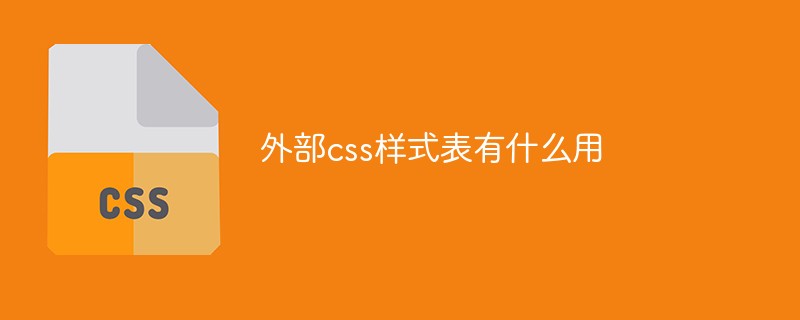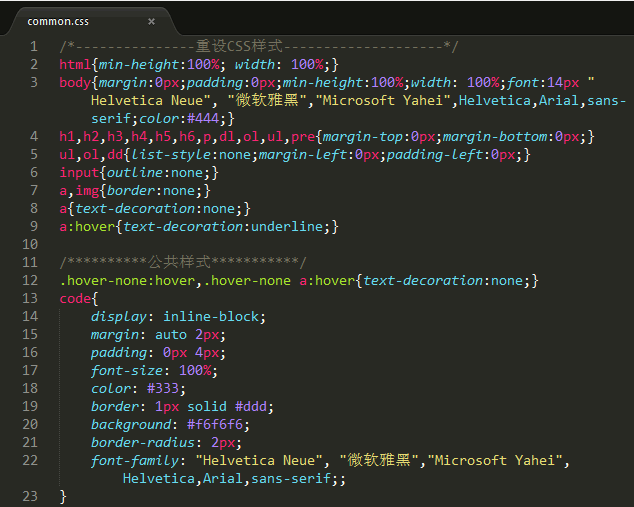What is the use of external css style sheets?
The functions of external css style sheets: 1. Separate styles from HTML, achieving complete separation of structure and performance code; 2. Convenient reuse and maintenance, reducing workload; 3. Reduce file size, Make the page structure easier to read by programmers and web crawlers; 4. Save network traffic and bandwidth; 5. Reduce rendering time; 6. Help search rankings, etc.

The operating environment of this tutorial: Windows 7 system, CSS3 version, Dell G3 computer.
If the CSS style is placed in a file outside the web page document, it is called an external style sheet. A CSS style sheet document represents an external style sheet.
In fact, the external style sheet is a text file with the extension .css. When you copy the CSS style code into a text file and save it as a .css file, it is an external style sheet. For example, the following picture:

The role of the external css style sheet:
Separates the style from the html, Complete separation of structure and performance code is achieved.
Convenient for reuse and maintenance, reducing workload. Because as long as the css style sheet file is modified, many web pages can be changed, and even the style and characteristics of the entire site can be changed. This avoids having to modify web pages one by one.
- Because it is separated into separate files, the size of the HTML file is greatly reduced, making the page structure easier to read by programmers and web crawlers
Write The resulting code file is more concise (easier for others to read) and the file size is smaller.
Can save network traffic and bandwidth when transferring code files. (Because the file is smaller and repeated css styles will be stored in the cache)
When the code file is rendered, the rendering time can be reduced. (Because the file is smaller)
Friendly to search engines, allowing search engines to rate the page higher, which is beneficial to the page’s search engine ranking
The external style sheet is cached on the user's computer after the user's first visit, and there is no need to load it on the next visit
(Learning video sharing: css video tutorial)
The above is the detailed content of What is the use of external css style sheets?. For more information, please follow other related articles on the PHP Chinese website!

Hot AI Tools

Undresser.AI Undress
AI-powered app for creating realistic nude photos

AI Clothes Remover
Online AI tool for removing clothes from photos.

Undress AI Tool
Undress images for free

Clothoff.io
AI clothes remover

Video Face Swap
Swap faces in any video effortlessly with our completely free AI face swap tool!

Hot Article

Hot Tools

Notepad++7.3.1
Easy-to-use and free code editor

SublimeText3 Chinese version
Chinese version, very easy to use

Zend Studio 13.0.1
Powerful PHP integrated development environment

Dreamweaver CS6
Visual web development tools

SublimeText3 Mac version
God-level code editing software (SublimeText3)

Hot Topics
 1386
1386
 52
52
 How to use bootstrap in vue
Apr 07, 2025 pm 11:33 PM
How to use bootstrap in vue
Apr 07, 2025 pm 11:33 PM
Using Bootstrap in Vue.js is divided into five steps: Install Bootstrap. Import Bootstrap in main.js. Use the Bootstrap component directly in the template. Optional: Custom style. Optional: Use plug-ins.
 The Roles of HTML, CSS, and JavaScript: Core Responsibilities
Apr 08, 2025 pm 07:05 PM
The Roles of HTML, CSS, and JavaScript: Core Responsibilities
Apr 08, 2025 pm 07:05 PM
HTML defines the web structure, CSS is responsible for style and layout, and JavaScript gives dynamic interaction. The three perform their duties in web development and jointly build a colorful website.
 How to write split lines on bootstrap
Apr 07, 2025 pm 03:12 PM
How to write split lines on bootstrap
Apr 07, 2025 pm 03:12 PM
There are two ways to create a Bootstrap split line: using the tag, which creates a horizontal split line. Use the CSS border property to create custom style split lines.
 Understanding HTML, CSS, and JavaScript: A Beginner's Guide
Apr 12, 2025 am 12:02 AM
Understanding HTML, CSS, and JavaScript: A Beginner's Guide
Apr 12, 2025 am 12:02 AM
WebdevelopmentreliesonHTML,CSS,andJavaScript:1)HTMLstructurescontent,2)CSSstylesit,and3)JavaScriptaddsinteractivity,formingthebasisofmodernwebexperiences.
 How to set up the framework for bootstrap
Apr 07, 2025 pm 03:27 PM
How to set up the framework for bootstrap
Apr 07, 2025 pm 03:27 PM
To set up the Bootstrap framework, you need to follow these steps: 1. Reference the Bootstrap file via CDN; 2. Download and host the file on your own server; 3. Include the Bootstrap file in HTML; 4. Compile Sass/Less as needed; 5. Import a custom file (optional). Once setup is complete, you can use Bootstrap's grid systems, components, and styles to create responsive websites and applications.
 How to insert pictures on bootstrap
Apr 07, 2025 pm 03:30 PM
How to insert pictures on bootstrap
Apr 07, 2025 pm 03:30 PM
There are several ways to insert images in Bootstrap: insert images directly, using the HTML img tag. With the Bootstrap image component, you can provide responsive images and more styles. Set the image size, use the img-fluid class to make the image adaptable. Set the border, using the img-bordered class. Set the rounded corners and use the img-rounded class. Set the shadow, use the shadow class. Resize and position the image, using CSS style. Using the background image, use the background-image CSS property.
 How to resize bootstrap
Apr 07, 2025 pm 03:18 PM
How to resize bootstrap
Apr 07, 2025 pm 03:18 PM
To adjust the size of elements in Bootstrap, you can use the dimension class, which includes: adjusting width: .col-, .w-, .mw-adjust height: .h-, .min-h-, .max-h-
 How to use bootstrap button
Apr 07, 2025 pm 03:09 PM
How to use bootstrap button
Apr 07, 2025 pm 03:09 PM
How to use the Bootstrap button? Introduce Bootstrap CSS to create button elements and add Bootstrap button class to add button text




